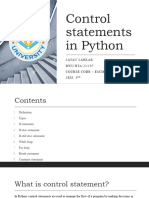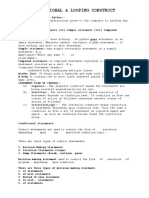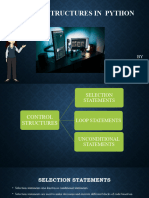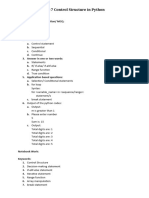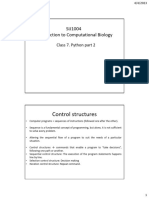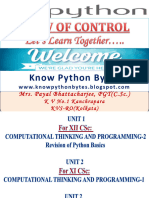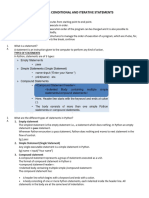Control Structures in Python – Viva Q&A; (Class
VIII, Chapter 7)
Basic Questions
1. What is a control structure in Python? → A control structure decides the flow of execution of a
program.
2. Why do we need control structures in programming? → To make decisions, repeat tasks, and
control the program flow.
3. What are the three types of control structures? → Sequential, Selection (decision-making),
Iteration (looping).
4. Define sequential execution. → Statements execute one after another in order.
5. What is decision making (selection) in Python? → Choosing different paths of execution using if,
if-else, if-elif.
Conditional Statements
6. Syntax of if statement → if condition: statement
7. How is if-else different from if? → if checks one condition, if-else gives two outcomes.
8. When do we use if-elif-else? → When more than two conditions are tested.
9. Can we write else without if? → No, else must follow if.
10. Output of: x=10 → Smaller
Looping Statements
11. What is a loop? → A loop repeats code until a condition is met.
12. Name two types of loops. → for loop, while loop.
13. Syntax of for loop → for variable in sequence: statement
14. Difference between for and while loop → for: fixed times, while: until condition true.
15. Entry-controlled loop? → Both for and while, as condition is checked before entry.
16. Example of while loop usage → Reading user input until 0 is entered.
17. Role of range() → Generates a sequence of numbers for iteration.
Jump Statements
18. Use of break → Exits loop immediately.
19. Difference between break and continue → break stops loop, continue skips current iteration.
20. Use of pass → Does nothing; placeholder.
21. Output of loop with break at 3 → 0, 1, 2
Higher Order
22. Else with loop? → Yes, runs if loop finishes without break.
23. While loop condition never false? → Infinite loop.
24. Nested loop possible? → Yes, a loop inside another loop.
25. Compare sequential, selection, iteration → Sequential: step by step; Selection: decision
making; Iteration: repetition.
















